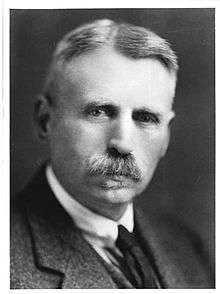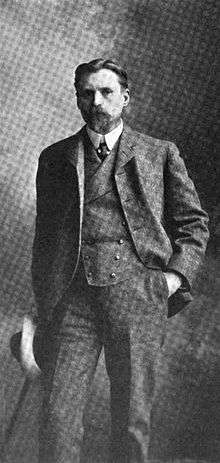George Horton

George Horton (1859–1942) was a member of the United States diplomatic corps who held several consular offices in Greece and the Ottoman Empire between 1893 and 1924. During two periods he was the U.S. Consul or Consul General at Smyrna (known as Izmir, Turkey today), 1911–1917 and 1919-1922.[1] The first ended when the U.S. entered World War I and diplomatic relations with the Ottoman Empire were terminated. The second covered Greek administration of the city during the Greco-Turkish War. The Greek administration of Smyrna was appointed by the Allied Powers following Turkey's defeat in World War I and the seizure of Smyrna.
Today Horton is best remembered for The Blight of Asia, his 1926 book about the events, notably the systematic ethnic cleansing of the Christian population, leading up to and during the Great Fire of Smyrna. He briefly summarizes events from 1822 to 1909 and covers in more detail, with eye-witness accounts, events from 1909 to 1922. The title refers to what he considered the abominable behavior of the Ottoman Turks, and by extension, all of Islam.
Personal life
George Horton was born on October 11, 1859 in Fairville in Wayne County, New York. In 1909, Horton married Catherine Sakopoulos and they had one daughter, Nancy Horton.[2]
Professional career

Horton was a literary man. He was a scholar of both Greek and Latin. He translated Sappho. He wrote a guide for the interpretation of Scripture. He wrote several novels and was a renowned journalist in Chicago, a party in the so-called Chicago Renaissance.
Journalist
Horton started his career as a literary journalist, first as literary editor of the Chicago Times-Herald (1899–1901), then as editor of the literary supplement of the Chicago American (1901–1903).
Diplomat
Horton was also both a professional diplomat and a lover of Greece or Philhellene. He became U.S. Consul in Athens in 1893, where he actively promoted the revival of the Olympic Games and inspired the U.S. team's participation. He wrote a lyrical visitor's guide to Athens and composed a reflective description of his stay in Argolis.
Horton served as U.S. Consul in Athens 1893-1898 and 1905-1906. He was US Consul General in Saloniki 1910–1911.
He then served as U.S. Consul in Smyrna 1911–1917, up to the termination of diplomatic relations with the Ottoman Empire in World War I. He served again after the war from 1919 until the Great Fire began on September 13, 1922, spending the last hours before his own evacuation signing passes for those entitled to American protection and transportation to Piraeus.
One of the keenest impressions which I brought away with me from Smyrna was a feeling of shame that I belonged to the human race— Horton[3]
The Blight of Asia
Today Horton is most remembered for his 1926 book The Blight of Asia which centers on the destruction of Smyrna. The fire ravaged Smyrna starting on September 13, 1922, two days after the Consul General's departure from his post there on September 11, and that lasted for 4 days.
Before publication Horton had resigned his diplomatic commission, and he wrote strictly in the capacity of a private citizen, drawing on his own observations and those of the people he quoted. His account remains as controversial as the fire itself.[4]
His account of the forced exodus of Christian inhabitants (Greek and Armenian), by Ottoman Turkish soldiers, chronicles the latter stages of the genocide of Asia Minor's native Christian population.[5]
Contemporary Communications
Horton quotes numerous contemporary communications including eyewitness accounts of the massacre of Phocaea in 1914, by a Frenchman, and the Armenian massacres of 1914/15, by an American citizen and by a German missionary. He also published letters that he received at the consulate from Americans living in Smyrna and radio messages that he received while traveling by ship from Smyrna to Athens, which recorded how many lives were being saved by the British Navy.
Review
According to James L. Marketos, Horton wanted his book to make four main points.[6]
First, he wanted to illustrate that the catastrophic events in Smyrna were merely "the closing act in a consistent program of exterminating Christianity throughout the length and breadth of the old Byzantine Empire."
Second, he wanted to establish that the Smyrna fire was started by regular Turkish army troops with, as he put it, "fixed purpose, with system, and with painstaking minute details."
Third, he wanted to emphasize that the Allied Powers shamefully elevated their selfish political and economic interests over the plight of the beleaguered Christian populations of Asia Minor, thereby allowing the Smyrna catastrophe to unfold without any effective resistance and, as he said, "without even a word of protest by any civilized government."
And fourth, he wanted to illustrate that pious western Christians were deluded in thinking they were making missionary headway in the Muslim world.
Media coverage
The New York Times of September 21 carried a story from Athens attributed to the Associated Press, reporting Horton's account of events in Smyrna. It opened in quotation marks with "the manner in which" he had summarized for the AP: "During my consulship at Saloniki I was bombed by Bulgars and Germans and during my official career I have had many rough experiences with submarines and fire, but never in my life have I seen anything like the Smyrna catastrophe."[7]
Return to the United States
Horton's November arrival in New York City was covered by The New York Times primarily in regard to his transport for the American Archaeological Society of thirty gold coins found at Sardis. They were believed to be minted for Croesus, and to represent the earliest coinage of gold anywhere. The story introduced him as "Dr. George Horton, United States Consul General at Smyrna, where he witnessed the burning and sacking of the ancient seaport and the evacuation of 40,000 refugees in five days ..." and closed with two paragraphs on Smyrna service, including recent personal loss of property and upcoming consultation in Washington concerning missing Americans.[8]
During the Smyrna catastrophe, Turkish military officer Nureddin Pasha had turned mitropolitan Chrysostomos over to an angry mob. The bishop was barbarically beaten, mutilated and killed.[9] Horton reportedly said, "I have known Monsigneur Chrysostomos for years. He was an active and enthusiastic exponent of Greek ambitions and ideals which it seems to me was quite natural in him as a Greek ... Greeks set him down in their history as a hero and martyr."[9]
See also
References
- ↑ Horton 2003, p. 105.
- ↑ "Horton", Index to Politicians, Political Graveyard (politicalgraveyard.com).
- ↑ Niki Karavasilis (2010). The Whispering Voice of Smyrna. Dorrance Publishing. p. 201. ISBN 978-1-4349-6381-9.
- ↑ Coleman, Brian, "George Horton: the literary diplomat", Byzantine and Modern Greek Studies, Volume 30, Number 1, January 2006, pp. 81-93(13). (subscription required)
- ↑ Horton 2003, back cover.
- ↑ Marketos, James L., "George Horton: An American Witness in Smyrna", American Hellenic Institute Noon Forum, September 14, 2006.
- ↑ "Our Smyrna Consul Praises Americans: Horton, in Athens, Says Countrymen Disregarded Their Own Safety to Aid Distressed", The New York Times, September 21, 1922, p. 3.
- ↑ "Brings Gold Coins Minted by Croesus: Dr. George Horton, Consul General at Smyrna, Arrives with Thirty Specimens", The New York Times, November 4, 1922, p. 28.
- 1 2 Stavridis, Stavros T., "Remembering Chrysostomos: a modern day martyr", National Centre for Hellenic Studies and Research, , Latrobe University, Melbourne, Australia. (Reprinted by?) The Chian Foundation.
- Citations
- Horton, George, The Blight of Asia, An Account of the Systematic Extermination of Christian Populations by Mohammedans and of the Culpability of Certain Great Powers; with a True Story of the Burning of Smyrna, Foreword by James W. Gerard, Indianapolis: Bobbs-Merrill, 1926.
- Horton, George, The Blight of Asia, An Account of the Systematic Extermination of Christian Populations by Mohammedans and of the Culpability of Certain Great Powers; with the True Story of the Burning of Smyrna, Foreword by James W. Gerard, Introduction by James L. Marketos, London: Gomidas Institute (Sterndale Classics), 2nd edition, 2008, ISBN 978-1903656-79-2. (1st edition 2003?)
External links
- Works by or about George Horton at Internet Archive
- The Blight of Asia (1926), full text at Hellenic Resources Network — unpaged with color highlights
- George Horton at Library of Congress Authorities — with 19 catalog records
|